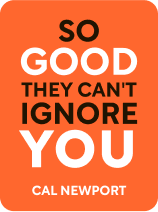

This article is an excerpt from the Shortform book guide to "So Good They Can't Ignore You" by Cal Newport. Shortform has the world's best summaries and analyses of books you should be reading.
Like this article? Sign up for a free trial here .
How can you dedicate your career to fulfilling your personal mission? What are the practical steps?
Having a mission is a trait of a lovable job. It focuses your career, and it’s useful to the world— it might even change the world. When your work makes a difference, you find more joy and satisfaction. You also make a bigger impact and leave a greater legacy.
Read more to learn about your personal mission in the context of your career.
Rule #4: Cash in Your Skills for a Personal Mission
In Rule #3, we looked at how to cash in your scarce and prized skills for autonomy. Now, we’ll look at how to cash them in for a personal mission, which, like autonomy, is one of the traits of a lovable job.
A mission is a useful, potentially world-changing goal that focuses your career. People who think their careers make a difference are happier and can better weather the difficulties of work. For example, for many people, putting in overtime is worth it if they’re saving lives.
In this chapter, we’ll look at how to find your general mission and then how to transform that mission into reality by pursuing specific projects.
Finding Your Personal Mission: The “Adjacent Possible”
Missions come from a space called the “adjacent possible”: the space just beyond the cutting edge of human knowledge.
The idea of the adjacent possible originally comes from biology, in which it refers to the potential for simple chemical structures to combine and form more complex structures. Before the simple structures combine, the complex structures don’t exist yet. Because the simple structures are the building blocks of the more complex ones, it’s perfectly possible they’ll eventually form.
Steven Johnson, author of Where Good Ideas Come From, adopted this term to describe inventions. New inventions nearly always come from the adjacent possible space because most discoveries build incrementally upon the current understanding. As each discovery advances the cutting edge further, a new adjacent possible space opens up, and that becomes filled, and so on.
For example, when oxygen was discovered in the 1770s, the cutting edge consisted of two relevant factors:
- Scientists realized that air wasn’t a void but actually contained material.
- Sensitive scales, which made precise experimentation possible, had just become available.
Anyone who was up to speed on the cutting edge could see the next step—use these two factors to isolate oxygen. Both Joseph Priestley and Carl Wilhelm Scheele isolated oxygen, independently, within two years of each other.
Like scientific discoveries, career missions come from the adjacent possible because they often need to be innovative in order to change the world. This is why missions are so hard to find—it takes a lot of work to get to the cutting edge at which they’re even visible. However, this difficulty is actually in your favor. It narrows the competition for mission-fulfilling jobs.
Developing Your Personal Mission
Coming up with an idea for a mission is the only the first step to cashing in your career capital—next, you need to figure out how to transform that idea into a reality.
There’s a three-step process to developing a personal mission. Each step of the process forms one level of a pyramid:
Bottom Level: Research
The bottom level is research in your field, which will help you develop career capital and approach the adjacent possible. To create a strong base for your pyramid, read papers, talk to experts in the field, attend lectures, and brainstorm.
(Shortform example: If you’re a novelist, you might attend writing conferences, participate in workshops, and dedicate an hour a week to analyzing bestselling novels.)
Middle Level: Little Bets
The middle level is inspired by Peter Sims’s Little Bets. Little Bets details the stories of innovative individuals and companies, and comes to the conclusion that these people and organizations never had a master plan—they had multiple small plans, or little bets. Each little bet provided feedback about what to do next. If the little bet didn’t pay off, they’d try a new direction. If it did pay off, they’d continue on. This allowed them to try out several options and see which one was most likely to succeed.
To help you figure out the best projects to pursue to achieve your personal mission, undertake small experiments that will give you feedback about whether you’re headed in the right direction.
Each little bet should have the following characteristics:
- It can be finished in fewer than 30 days.
- It forces you to learn a skill or create something new.
- Its result offers feedback.
For example, Kirk French, an archaeologist at Penn State, didn’t know exactly how he was going to achieve his mission of using media to popularize archaeology. His first little bet was to digitize a 1961 documentary about the Teotihuacan Valley in Mexico, which was a notable example of historical ecology. This took him only a few months and went well, and his next little bet was to create an updated version of the documentary.
Then, one day, a man called the archaeology department, claiming that he’d found a Knights Templar treasure. Everyone in the department wrote him off as a waste of time, but Kirk decided to undertake another little bet and talk to the man, because talking to the public about archaeology fit nicely with his personal mission. Kirk filmed their meeting and decided he’d meet with and film everyone who called the department about a discovery. Kirk didn’t know where the project would go but decided he could at least show the videos to his archaeology students.
This turned out to be the little bet that led Kirk to a job he loved. The Discovery Channel wanted to put together a show about archaeology, and when a production company called Penn State, Kirk sent them his videos, which they loved. Kirk became the host of a show called American Treasures.
Top Level: Tentative Mission
The top level is a statement that describes an approximate mission. The statement can be frequently edited as you acquire career capital from the bottom level and get feedback from your little bets in the middle level.
(Shortform example: “Use dance to teach youth how to express themselves in a healthy way.”)
Adopting a Marketing Mindset
Once you’ve found your personal mission and started to develop it by pursuing projects, adopt a marketing mindset in order to share it with the world. The more people interact with your mission, the greater your world-changing ability is.
The marketing mindset comes from Giles Bowkett, who was in turn inspired by a combination of ideas in two books, Purple Cow by Seth Godin and My Job Went to India by Chad Fowler.
Purple Cow is a book about marketing that explains that if you want someone to notice something—in your case, your mission—it needs to be remarkable. For example, people see brown cows all the time, but not purple ones, so because of its novelty, a purple cow will be inherently more interesting. If your personal mission is remarkable, people will talk about it, spreading it widely and increasing your reach. (Shortform note: Read our summary of Purple Cow here.)
My Job Went to India specifically offers career tips for software developers, but one of the tips is more widely applicable—market your remarkable project (or mission) on a platform that’s highly visible and respected. The more visible you can make your mission, the more people will encounter it, again increasing your reach.
For example, after deciding on a mission to combine technology with art, Giles Bowkett built Archaeopteryx, an AI program that composes its own dance music. Few programmers knew how to compose music, and few musicians knew programming, so the project was remarkable—Giles was probably the only person in the world who could have built it.
The next step was to share this one-of-a-kind program. Giles went to speak at conferences and publicly released the program’s code to the open-source community, which is a community of people who share and work on each other’s projects for free. Many programmers and employers keep an eye on open-source platforms because they’re a good place to discover new talent, so plenty of people found out about Archaeopteryx.
Failed Application of Rule #4: Sarah the Grad Student
Sarah had just started studying cognitive science when she began searching for her personal mission. She hadn’t acquired enough career capital to reach the cutting edge yet, so there was no way she could see into the adjacent possible at this point. Instead of taking the time to amass capital, she had a crisis—she was torn between theoretical work and applied work, and felt like she had too many conflicting interests. She struggled to settle on a mission.
Successful Application of Rule #4: Pardis Sabeti
Unlike Sarah, Pardis Sabeti didn’t start looking for her personal mission until she reached the cutting edge, and she made multiple little bets to get there.
When Pardis was in high school, she loved math. Then, she encountered an excellent biology teacher and ultimately decided to study biology at MIT. She thought she wanted to be a doctor but went on to earn her Ph.D. in genetics at Oxford University. While there, she decided to study infectious diseases in Africa. She worked in a lab that used genetic analytics to track ancestry, and then switched to studying the genetics of malaria. Finally, she did decide to do her MD. All of this study built up Pardis’s career capital and brought her to the cutting edge.
By the time Pardis was working at the Broad Institute, a research center, she had developed her knowledge of genetics enough to see into the adjacent possible. She saw a way to use genetics to try to cure ancient diseases such as malaria and decided to make this her mission. She’d recently written a popular paper and had job offers coming in, and she took a professorship at Harvard, using her career capital to buy herself a job that allowed her to work towards her mission.
Author’s Application of Rule #4
After accepting a job at Georgetown, the author started looking for a personal mission. He’d just finished a Ph.D. and was at the cutting edge, so it was an appropriate time. He’d spent a lot of time working with distributed algorithms and could see the potential to use them in multiple fields, so he decided to make their application his mission. As for how he would actually pursue this mission, he consulted the mission development system.
To fill out the bottom of his pyramid, he read papers, talked to experts, went to lectures, and then summarized his findings. He also went for walks to give himself time to brainstorm.
To fill out the middle, he ran two or three little bets at a time. If they went well, he continued the project. If not, he tried something else.
At the top of his pyramid, he placed the tentative mission: to use distributed algorithm theory in new settings to create results.
At the time of the book’s writing, the author hadn’t yet started his job at Georgetown so couldn’t offer more about how his personal mission was developing, but he’s confident he’ll like what he does and that he’ll like it even more as he does it for longer.

———End of Preview———
Like what you just read? Read the rest of the world's best book summary and analysis of Cal Newport's "So Good They Can't Ignore You" at Shortform .
Here's what you'll find in our full So Good They Can't Ignore You summary :
- What makes people love their work
- Why following your passion is not the path to loving your work
- The four rules for loving your work






